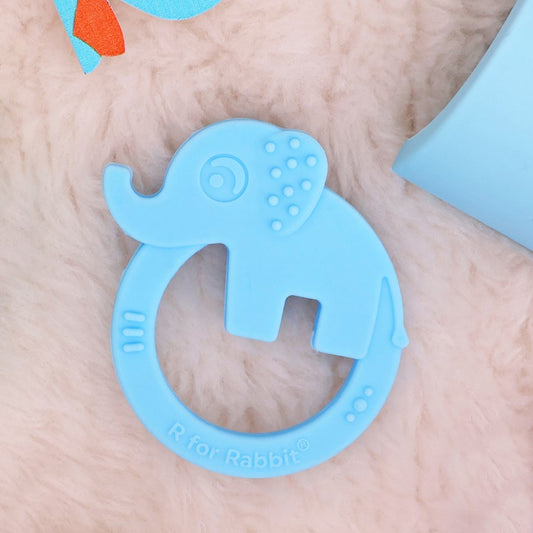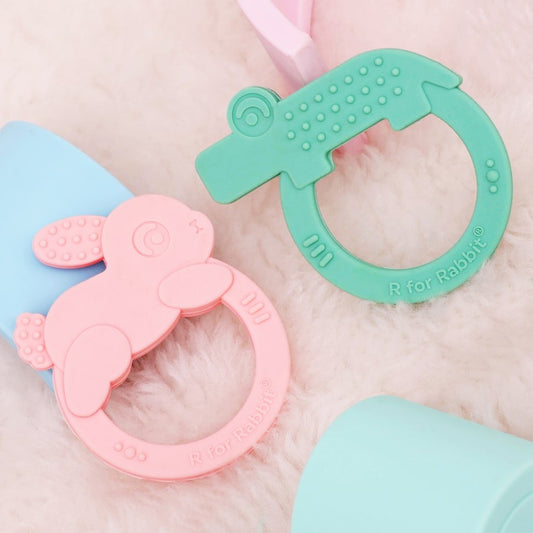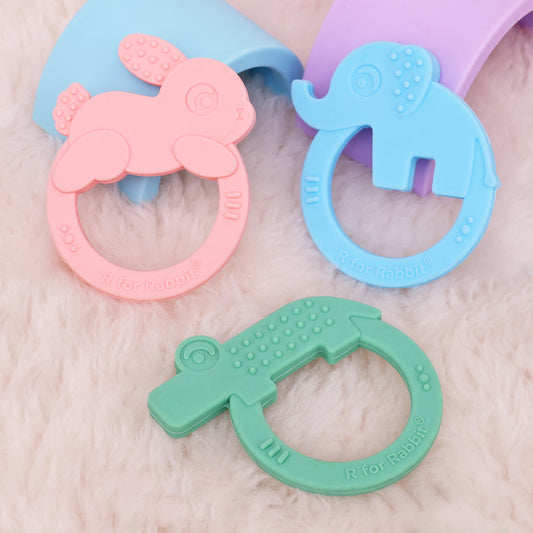Safety Considerations for Silicone vs. Rubber Teethers

Teethers can be considered teething relief tools for babies during their teething spurts. They Prevent sore gums by putting pressure on the painful teething process in infants.
Do you often find your child drooling, being fussy, or trying to put everything in their mouth? Now if your baby is 3 months old, congratulations!
Your little munchkin is only a few months away from transitioning to solid food.
In addition, are you confused about which teether to give your child for their optimum teeth and overall sensory development?
Silicone and rubber teethers are considered the safest options as the kids’ teething tools.
This is due to their non-toxicity, gentleness, softness, and comfortable impact on the baby’s soft and sensitive gums.
However, both are optimum in their ways, but this blog will give you a deep understanding of silicone vs. rubber teether safety, durability, affordability, and more.
Understanding Silicone and Rubber Teethers
Let us now understand some key differences between silicone and rubber teethers in terms of their source of origin, manufacturing, durability, popularity, and more.
|
Feature |
Silicon Teethers |
Rubber Teethers |
|
Composition |
Made from food-grade silicon, non-toxic, and heat-resistant. |
Made from natural rubber or synthetic latex, more porous. |
|
Manufacturing |
Molding/extrusion, food-grade, heat-cured. |
Compression/molding requires the refining of latex. |
|
Texture |
Soft, flexible, smooth surface |
Firmer, and may have a more textured surface, more elastic. |
|
Durability |
Long-lasting, heat-resistant, non-degradable. |
Less durable, and can degrade with exposure to light/heat. |
|
Cost |
More expensive due to raw material and manufacturing costs. |
Less expensive, budget-friendly. |
|
Popularity |
Highly popular in urban areas among health-conscious parents. |
Long-lasting and popular in rural/price-sensitive markets. |
|
Availability |
Readily available online and also in retail stores. |
Available in local markets as it is widely distributed. |
Key Safety Considerations
Although both rubber and silicone teethers have their pros and cons, it is important to understand them in a little detail.
So, let us now delve into the key safety considerations of both silicone teethers and rubber teethers.
1. Toxicity Risks
Silicone
The silicone teethers’ safety is defined by its process of conversion from natural sand to silicone polymer, which is safe for babies.
The process of molding the silicone polymer into various shapes is done with heat or by using UV light. This step makes it baby-friendly because UV light is used to kill various harmful toxins.
It is also free from various intoxicants like BPA, phthalates, and PVC, which makes it non-toxic and unsafe for babies. It is a very stable compound that hinders its chemical reaction with any other compounds, thus also freeing it from any unwanted allergies.
Demerits of exposure to BPA, phthalates, and PVC
- Hormonal misbalance causes either early puberty or gender developmental issues.
- It causes impaired brain and intellectual development.
- It also increases the risk of allergies, asthma, coughing, wheezing, and other respiratory problems.
- Lack of active development in terms of language, behavior, and concentration in babies.
- Could also lead to obesity due to its metabolism disruption in children.
- Compromises the immune system.
Rubber
This is produced either from natural rubber trees or synthetically in the lab. In either case, one of the most prominent sensitivity risks is latex allergy. Babies who might have this allergy can have serious consequences like swelling, hives, difficulty in breathing, etc.
Also, the vulcanization process of the rubber involves the usage of sulfur, which has the potential of leaching toxicity with increased exposure to heat, moisture, and saliva. Since rubber has the potential to break with time, the tiny pieces also have a risk of being ingested by babies.
Sometimes the coloring agents that are used to color the rubber also contain harmful toxins and heavy metals that are very dangerous to the baby’s health.
In addition, the use of the fertilizer during its cultivation also has a risk of being transferred to the babies during its usage.
Sometimes, the PVC and phthalates are used to enhance the rubber’s flexibility, which has also increased developmental risks in babies.
2. Durability and Maintenance
Silicone
This is considered very durable due to its resistance to high temperatures ranging from -75 degrees Celsius to 350 degrees Celsius. Also, it is chemically very stable which prevents further chemical interactions, leading to leaching or intoxication.
In addition, it is also non-porous which makes its maintenance easy due to the non-absorbent property of silicone.
Rubber
It is very flexible and strong initially but tends to lose its shape, strength, and porosity with time. With regular usage, it can crack, become stiff, or even lose its elasticity.
Rubber also tends to absorb odors from everything it comes into contact with, such as food, sweat, or other strange odors caused by its high porosity. This makes cleaning more difficult. This, thus, compromises its hygiene and maintenance for the babies.
It is also susceptible to wear and tear, high moisture, high temperature, and constant stretching, thus making it a risk of ingestion in babies.
3. Bacterial Growth
Silicone
The smooth surface of the silicone prevents anything such as food or dirt from sticking to the surface. This makes it especially safe for babies.
Moreover, the non-porous quality makes this product a healthy choice for babies because it has resistance to bacteria and various environmental pollutants.
Rubber
Rubber is naturally porous. This causes a high risk of contamination from everything it comes in contact with, thus, making it unsafe for babies after using it for a while.
4. Environmental Impact
Silicone
High wear resistance makes it extremely durable and resistant to heat and humidity. It also increases shelf life. This reduces the need to recycle frequently.
Moreover, their production has a lower carbon footprint compared to other materials which makes it environmentally friendly in the long run.
Rubber
Even though it comes from natural sources, its cultivation and production require a lot of chemicals. This increases carbon dioxide emissions in the environment and makes it less environmentally friendly when compared to silicone.
Synthetic rubber is also more harmful to the environment because it contains many harmful toxins that make biodegradation impossible.
Recyclable teethers also have the potential to increase soil and water pollution by releasing microplastics into landfills.
5. Affordability and Availability in India
Silicone teethers
Due to the high safety consideration for silicone teethers, they are slightly more expensive than rubber teethers.
This is because it is durable, safe, and has highly non-toxic properties. Some companies also use high-quality food-grade silicone, which increases costs
It costs between Rs. 300/- and Rs. 1,500/- depending on multiple finishes or custom designs. It's a bestseller in brands such as R for Rabbit, Mamaearth, LuvLap, Chicco, and Sophie the Giraffe.
It can be purchased from various e-commerce websites like Amazon, Flipkart, First Cry, various baby product retailers, and even pharmacies.
Rubber teethers
In addition to good safety considerations for natural rubber teethers, it is also more feasible compared to silicone teethers.
The average cost for rubber teethers varies between Rs. 200/- and Rs. 700/-, depending upon its design, brand, and size.
They are available both online and offline due to their long and extensive production line. They can be purchased from popular brands such as Pigeon, Mee Mee, and Chicco, or small-town retailers, pharmacies, and even local markets.
However, be very careful where you buy them from because the presence of synthetic latex can sometimes cause many respiratory and developmental problems in infants.
Expert Recommendations and Studies
There have been many studies and research about the safety considerations of the teethers.
It was concluded that parents must always choose non-toxic, BPA- and phthalate-free teethers for babies' overall healthy growth and development.
It was also found that gel-or liquid-filled teethers contain harmful toxins that have various hormonal, endocrine, neurological, immune, and various other health issues in children.
This happens when they bite into the teethers, which might enable the baby to ingest a few harmful toxins.
Food-grade silicone, natural rubber, and wooden teethers have always been confirmed to be baby-safe by both parents and pediatricians.
This is because teethers containing BPA, phthalates, and PVC have a high risk of leaching out due to their chemical instability.
The chemical leaching is the consequence of the teethers’ regular interaction with saliva, temperature changes, sweat, improper hygiene, and the material’s depreciation with time, if it is not chemically stable.
Also Read: How To Choose the Right Teether To Match Your Baby's Age?
Practical Tips for Indian Parents
Let us now understand some useful tips for Indian parents to provide their kids with the best teethers during their teething journey.
Tip 1: How to Identifying the High-Quality Silicone and Rubber Teethers
|
Factors of Assessment |
High-quality Silicone Teether |
High-quality Rubber Teether |
|
Material Type |
100% food-grade silicone(free from BPA, phthalates and PVC) |
100% natural rubber(free from BPA, phthalates, and synthetic additives) |
|
Texture and Flexibility |
Smooth, flexible, and firm enough to soothe the gums(nor too hard not too soft) |
Soft, flexible, and mimics the feel of a mother’s nipples. |
|
Odor |
Odorless |
Natural, non-chemical smell |
|
Color |
Non-toxic, food-safe colors |
Natural, non-toxic colors(might vary on rubber’s natural color) |
|
Surface |
Smooth, with no rough or sharp edges. |
Smooth with no imperfections |
Tip 2: Signs Of Wear And Replacement Guidelines
- Regularly inspect for wear and tear and replace the teether immediately in case of a visible crack.
- If the teether is fading, it indicates chemical leaching and should be immediately replaced.
- If it is breaking or losing its natural shape, it might be due to rough usage or its exposure to heat or moisture.
- Rubber tends to become sticky when it is breaking down in quality. This also opens up the possibility of the risk of infections.
Tip 3: Trusted Brands And Certifications To Look For In India
Some of the trusted brands include R for Rabbit, The Moms Co., Mee Mee, Chicco, Mothercare, Pigeon, and LuvLap.
Also, some of the certifications that authenticate the teethers’ quality are BIS, FDA, CE Marking, ISO 9001, ASTM F963, non-toxic and BPA-free labeling, eco-certifications, India’s Green Seal, and Child Safety Certification.
Tip 4: Alternatives To Teething Tools And What Not To Do
Some of the best alternatives for teething tools include:
- Place a soft cloth in the refrigerator for 10 minutes and let your baby chew on it.
- Chop cool fruits and vegetables like cucumbers, apples, and carrots.
- Frozen breast milk or fruit popsicles, but be careful of the cold temperatures.
- Massage your baby's gums with coconut or almond oil as they have anti-inflammatory properties.
- Chamomile or ginger tea is recommended for older babies. This is because it has anti-inflammatory and soothing properties.
Conclusion
According to the parents, the most efficient ways to soothe the teething in babies include food for chewing (45.7%), teething rings (42.1%), cuddles (17.1%), gum rubs (15.8%) and ice massage on gums (10.9%).
This implies that the teething rings are the second most preferred choice among parents.
This battle between silicone vs. rubber teethers' safety has proved that both food-grade silicone and natural rubber are good for babies, except for their differences in durability, price variability, and carbon footprint.
Moreover, nothing is beyond children’s safety and because dental teethers are put directly into the mouth, understanding their safety considerations is very important for the baby's overall development.
Although these products work wonders for soothing a baby's sore gums during the teething process, making an informed purchasing decision is important. This is because these toys may not seem important but will affect your child's health in the long run.











